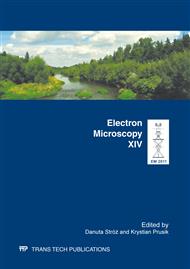p.1
p.7
p.13
p.16
p.20
p.24
p.28
p.32
p.37
Cathodoluminescence and Electroluminescence of Semiconductor Structures in SEM
Abstract:
Cathodoluminescence (CL) in SEM and electroluminescence (EL) techniques are widely used for investigation of optical properties of electronic structures. It is assumed that the CL signal represents the local properties of the region irradiated by the electron beam. However, this assumption is true if there is no electric field in the excitation region. In the opposite case the electron-hole pairs generated by the electron beam are separated by the electric field and the local voltage source is generated. The voltage is distributed all over the structure through resistance paths and it causes a current flow, which presence affects the registered CL signal. A range of this effect depends on the resistance distribution within the structure and on the value of electron beam current. The range may be much longer than the diffusion length of minority carriers. When EL signal is measured in SEM, it represents the mean properties of the whole structure. The comparison of the CL results with the EL ones detected in SEM gives valuable information about the examined structures, as will be shown in the present investigations. The AlGaAs/GaAs heterostructures with 8 nm InGaAs quantum well have been examined. For that aim also special test structures for CL and EL measurements have been formed on standard epitaxial structures.
Info:
Periodical:
Pages:
20-23
Citation:
Online since:
March 2012
Price:
Сopyright:
© 2012 Trans Tech Publications Ltd. All Rights Reserved
Share:
Citation:


